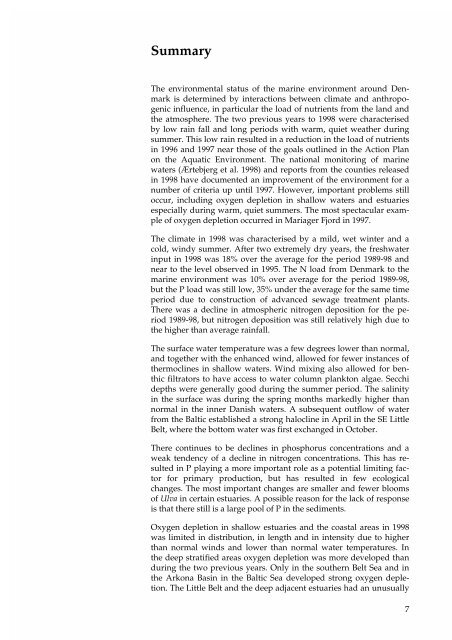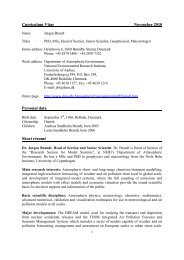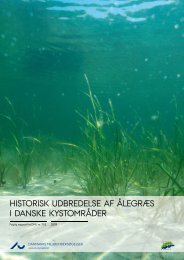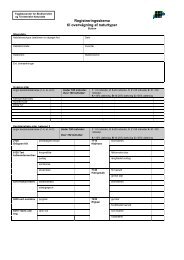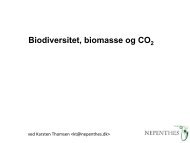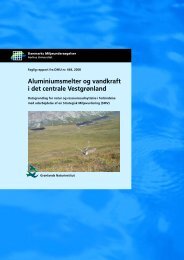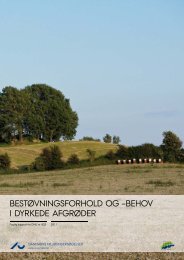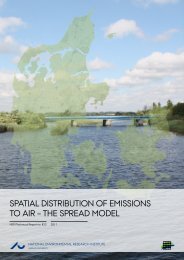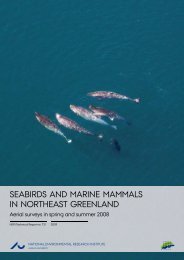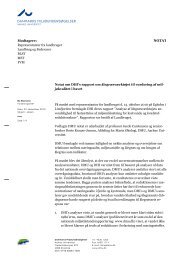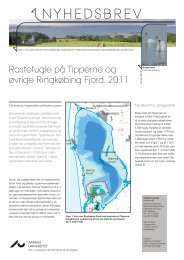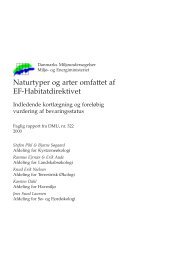Marine områder - Status over miljøtilstanden i 1998 - Faglig rapport ...
Marine områder - Status over miljøtilstanden i 1998 - Faglig rapport ...
Marine områder - Status over miljøtilstanden i 1998 - Faglig rapport ...
Create successful ePaper yourself
Turn your PDF publications into a flip-book with our unique Google optimized e-Paper software.
Summary<br />
The environmental status of the marine environment around Denmark<br />
is determined by interactions between climate and anthropogenic<br />
influence, in particular the load of nutrients from the land and<br />
the atmosphere. The two previous years to <strong>1998</strong> were characterised<br />
by low rain fall and long periods with warm, quiet weather during<br />
summer. This low rain resulted in a reduction in the load of nutrients<br />
in 1996 and 1997 near those of the goals outlined in the Action Plan<br />
on the Aquatic Environment. The national monitoring of marine<br />
waters (Ærtebjerg et al. <strong>1998</strong>) and reports from the counties released<br />
in <strong>1998</strong> have documented an improvement of the environment for a<br />
number of criteria up until 1997. However, important problems still<br />
occur, including oxygen depletion in shallow waters and estuaries<br />
especially during warm, quiet summers. The most spectacular example<br />
of oxygen depletion occurred in Mariager Fjord in 1997.<br />
The climate in <strong>1998</strong> was characterised by a mild, wet winter and a<br />
cold, windy summer. After two extremely dry years, the freshwater<br />
input in <strong>1998</strong> was 18% <strong>over</strong> the average for the period 1989-98 and<br />
near to the level observed in 1995. The N load from Denmark to the<br />
marine environment was 10% <strong>over</strong> average for the period 1989-98,<br />
but the P load was still low, 35% under the average for the same time<br />
period due to construction of advanced sewage treatment plants.<br />
There was a decline in atmospheric nitrogen deposition for the period<br />
1989-98, but nitrogen deposition was still relatively high due to<br />
the higher than average rainfall.<br />
The surface water temperature was a few degrees lower than normal,<br />
and together with the enhanced wind, allowed for fewer instances of<br />
thermoclines in shallow waters. Wind mixing also allowed for benthic<br />
filtrators to have access to water column plankton algae. Secchi<br />
depths were generally good during the summer period. The salinity<br />
in the surface was during the spring months markedly higher than<br />
normal in the inner Danish waters. A subsequent outflow of water<br />
from the Baltic established a strong halocline in April in the SE Little<br />
Belt, where the bottom water was first exchanged in October.<br />
There continues to be declines in phosphorus concentrations and a<br />
weak tendency of a decline in nitrogen concentrations. This has resulted<br />
in P playing a more important role as a potential limiting factor<br />
for primary production, but has resulted in few ecological<br />
changes. The most important changes are smaller and fewer blooms<br />
of Ulva in certain estuaries. A possible reason for the lack of response<br />
is that there still is a large pool of P in the sediments.<br />
Oxygen depletion in shallow estuaries and the coastal areas in <strong>1998</strong><br />
was limited in distribution, in length and in intensity due to higher<br />
than normal winds and lower than normal water temperatures. In<br />
the deep stratified areas oxygen depletion was more developed than<br />
during the two previous years. Only in the southern Belt Sea and in<br />
the Arkona Basin in the Baltic Sea developed strong oxygen depletion.<br />
The Little Belt and the deep adjacent estuaries had an unusually<br />
7


